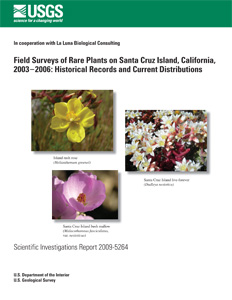Scientific Investigations Report 2009–5264
ABSTRACT
Santa Cruz Island is the largest of the northern Channel Islands located off the coast of California. It is owned and managed as a conservation reserve by The Nature Conservancy and the Channel Islands National Park. The island is home to nine plant taxa listed in 1997 as threatened or endangered under the federal Endangered Species Act, because of declines related to nearly 150 years of ranching on the island. Feral livestock were removed from the island as a major conservation step, which was part of a program completed in early 2007 with the eradication of pigs and turkeys. For the first time in more than a century, the rare plants of Santa Cruz Island have a chance to recover in the wild. This study provides survey information and living plant materials needed for recovery management of the listed taxa. We developed a database containing information about historical collections of the nine taxa and used it to plan a survey strategy. Our objectives were to relocate as many of the previously known populations as possible, with emphasis on documenting sites not visited in several decades, sites that were poorly documented in the historical record, and sites spanning the range of environmental conditions inhabited by the taxa. From 2003 through 2006, we searched for and found 39 populations of the taxa, indicating that nearly 80 percent of the populations known earlier in the 1900s still existed. Most populations are small and isolated, occupying native-dominated habitat patches in a highly fragmented and invaded landscape; they are still at risk of declining through population losses. Most are not expanding beyond the edges of their habitat patches. However, most taxa appeared to have good seed production and a range of size classes in populations, indicating a good capacity for plant recruitment and population growth in these restricted sites. For these taxa, seed collection and outplanting might be a good strategy to increase numbers of populations for species recovery. Several taxa have particular problems evidenced by lack of fruit set, very small population sizes, or unstable habitats. We collected seeds of all but two taxa for seed banking, and live cuttings of two clonal shrubs for cultivation at the Santa Barbara Botanic Garden. The survey data, seeds and cuttings provide a baseline and a foundation for planning, conducting, and tracking recovery of the nine federally listed plant taxa of Santa Cruz Island. |
First posted April 22, 2010 For additional information contact: Part or all of this report is presented in Portable Document Format (PDF); the latest version of Adobe Reader or similar software is required to view it. Download the latest version of Adobe Reader, free of charge. |
McEachern, A.K., Chess, K.A., and Niessen, K.G., 2010, Field surveys of rare plants on Santa Cruz Island, California, 2003–2006: Historical records and current distributions: U.S. Geological Survey Scientific Investigations Report 2009–5264, 34 p.
Abstract
Introduction
Results
Discussion
Conclusions
Acknowledgments
References Cited
Appendix A. Historic and Current Occurrences of Federally Listed Plants on Santa Cruz Island, California